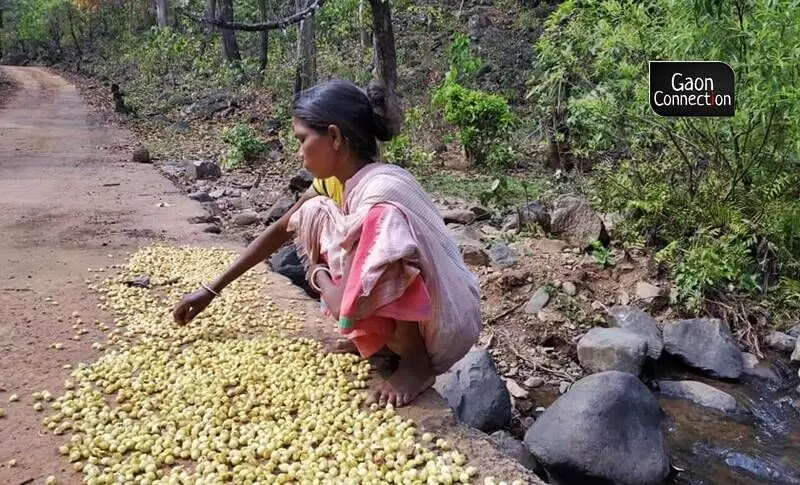Odisha: Mayurbhanj's tribal families toil in the mahua season while the middlemen flourish
The labour-intensive mahua picking is vital for the Adivasi villagers in Odisha. But because of no direct access to the market, the tribal people sell mahuli flowers to middlemen for Rs 25 to Rs 30 a kilo, which in turn is sold by them at double the rate to country liquor shops.
 Ashis Senapati 20 April 2022 4:43 PM GMT
Ashis Senapati 20 April 2022 4:43 PM GMT

Mahua flower is one of the most important non-timber forest produce (NTFP) in India, contributing a major share to the tribal economy of the country. All photos by arrangement.
In the months of March and April every year, Anlakata village in Mayurbhanj district wears a deserted look. Except its old and sick residents, all the other tribal villagers, including their young children, leave for the forest early in the morning and spend the entire day there collecting mahua (Madhuca longifolia) flowers, locally known as Mahuli.
The labour-intensive mahua picking is vital for these Adivasi villagers in Odisha who consume these flowers as food, make wine from it, and also sell it to earn their livelihoods. However, with no direct access to the market, these tribal communities end up selling mahua flowers to the middlemen at a throwaway price.
"The mandi is far from our house. There is no transport available for villagers like us. I don't think it makes any sense for us to argue about the money with the middleman. We happily take whatever is given to us, that's how it has been since my childhood," 57-year-old Rangalata Munda, a mahuli collector, told Gaon Connection.
Tribal activist Kiran Kujur who works for the rights of the rural residents in the area informed Gaon Connection that the mahua collected by the villagers is sold at twice the price paid to them by the middlemen.
"Mahua collectors generally sell a kilogram of dry mahua flower at Rs 25 to Rs 30 to the middlemen. But the middlemen further sell dry mahua to country liquor units at Rs 50 to Rs 60 a kilo," Kujur said.
Odisha is an important contributor to the country's mahua economy. Nearly three-fourth of entire tribal households (approximately 7.5 million individuals) in the country are involved in collection of mahua flowers. The estimated national production of mahua is 0.85 million tonnes, whereas the total production potential is 4.9 million tonnes.
Average trade value of mahua flowers in Madhya Pradesh is around 5,730 metric tonnes, 2,100 metric tonnes in Odisha, and Andhra Pradesh produces about 13,706 quintals of mahua flowers (worth Rs 8.4 million) and 6188 quintals of mahua seeds (worth Rs 6.5 million).
Mahua collection is hard labour
Arikhita Banara, a teacher who teaches at a school situated in Chheliposi (almost seven kilometres away from Anlakata village), said that she daily witnesses these tribal villagers' march to the forests to pick mahuli flowers. She told Gaon Connection that despite the unfair payment these rural residents receive for mahua, they have no option but to spend hours collecting these flowers.
"The income is very poor in proportion to the hard labour and risks involved. These poor people risk their lives as forests are full of wild animals," Banara said. "They wake up early in the morning and go to the forest for mahua collection. At noon, they come back for food and some rest and return to the forests in the evening. This is their daily routine in the summer months," she added.
"During mahuli season, I earn around Rs 150 to Rs 200 per day by collecting the flowers in the nearby forest. The forest is the abode of many elephants, leopards and other animals," said 57-year-old Munda. "But to earn money, villagers and their children go into dense forests to collect mahuli. I know villagers who died or were seriously injured upon encounters with wild animals," she added.
No MSP policy on mahua in Odisha
Interestingly, despite the Union Ministry of Tribal Affairs including mahua under the ambit of the minimum support price for non-timber forest produce (NTFP), the Odisha government has no provision to do so.
When contacted Chandan Gupta, the marketing manager of Tribal Development Co-operative Corporation of Odisha Limited said, "We have not included mahua under MSP in Odisha. Excise department provides licences to country liquor makers to collect mahua from the people directly".
When Gaon Connection approached the excise superintendent of Mayurbhanj district, the official admitted that the middlemen often exploit villagers who have no option but to sell them to these traders.
"So far, the excise department has no role to prevent middlemen in this mahua trade," Ashok Kumar Seth told Gaon Connection.
But, Kujur, the tribal activist asserted that country liquor manufacturing units should directly purchase mahua flowers from these poor collectors.
"Eradication of middlemen is necessary to help these mahua flower collectors. The markets need to be accessible by the villagers in order to get better prices for their produce," the tribal activist noted.
Mahua flower is one of the most important non-timber forest produce (NTFP) in India, contributing a major share to the tribal economy of the country. The collection and trade of mahua flowers provides employment to 28,600 persons per year, whereas, the potential is 163,000 persons per year, notes a 2019 research paper, Mahua (Madhucaindica): A boon for tribal economy.
On an average, each person can collect about 70 kilograms (kg) of dry flowers in a good flowering season. Flowering occurs over four to six weeks (March to May). However, the collection period is for 15-20 days when maximum flowering takes place. Average annual yield of a mahua tree is 50.756 kg per tree. For instance, in Odisha, on an average, each family collects about five to six quintals of mahua flowers per season, which contributes up to 30 per cent of their annual cash income.
#Mahua #Odisha tribals #story
More Stories




